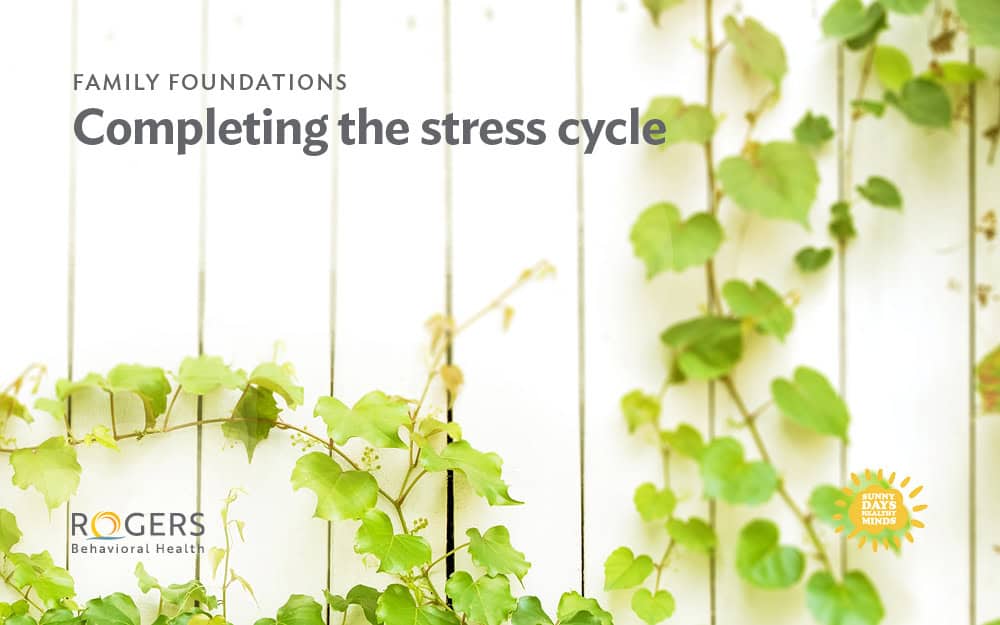Are your neck and shoulders tense? Feeing anxious and irritable? Chances are it’s due to stress, which can be defined as the body’s nonspecific response to any demand – pleasant or unpleasant. Stress can take a serious toll on our minds and bodies if we don’t deal with how it impacts us daily.
In part one of our Family Foundations: How to Build a Stronger, Healthier Home series, Rogers’ Dr. Nicholas Mahoney reviewed the Surgeon General’s advisory about the high levels of stress for parents and caregivers and gave five ways to protect mental health.
In today’s blog, Rogers’ Emily Jonesberg, MSW, LCSW, program manager for Community Learning and Engagement and WISE shares strategies for completing the stress cycle and explains why it’s important to our overall well-being.
What does it mean to complete the stress cycle?
I’ve found two books to be helpful resources on the topic: Burnout: The Secret of Unlocking the Stress Cycle and My Grandmother’s Hands: Racialized Trauma and the Pathway to Mending Our Hearts and Bodies.
 Completing the stress cycle means intentionally addressing and releasing the physical effects of stress on our bodies. This is different from managing the stressor, or source of the stress. Oftentimes, we need to work through the stress our bodies accumulate after a challenging situation or interaction first. Only then can we approach the root cause from a more emotionally grounded place.
Completing the stress cycle means intentionally addressing and releasing the physical effects of stress on our bodies. This is different from managing the stressor, or source of the stress. Oftentimes, we need to work through the stress our bodies accumulate after a challenging situation or interaction first. Only then can we approach the root cause from a more emotionally grounded place.
Why is completing the stress cycle important?
When we’re feeling stressed, our bodies are responding to some sort of trigger. We’re typically feeling unsafe in some way. It doesn’t necessarily mean that we’re literally feeling physically unsafe in the moment, but something is keeping our body in that state of elevated awareness and activating the fight, flight, or freeze response. Fight could look like being irritated or feeling frustrated. Flight could be feeling worried and anxious. Freeze could be feeling a sense of being numb or paralyzed.
The literature is saying it’s critical for us to complete the stress cycle as soon as we can for several reasons:
- It helps our bodies reregulate. When we’re in a constant state of feeling some level of stress, our bodies are focused on the fight, flight, or freeze response and they’re unable to tend to all the other pieces of our well-being, like our heart rates and breathing.
- It prevents the effects of hanging onto stress long term, which can create challenges to our physical and mental well-being.
- It takes time to feel the positive effects of completing the stress cycle once we become more intentional about it.
- It leads to things like burnout and compassion fatigue, which is our ability to care for others. We’re not in a grounded state of mind and unable to use our skills and be our best selves. We’re much more likely to pull up stereotypes we’ve received over time and perpetuate them when we’re interacting with others because we’re not in a place of wellness.
I’ve read about animals shaking off stress and have seen that in my own dog. After she’s had a stressful encounter with another dog or she’s been in a high-stress environment, she literally does a shake off. Lots of animals do this as their way of completing the stress cycle. They’re literally shaking the energy off to reground themselves. Humans do this sometimes when they’ve come out of surgery or sometimes, after a really stressful situation, our bodies shake as a natural response to release the stress.
What can we do to complete the stress cycle?
There are several ways we can complete the stress cycle:
- Move. Get between 20 and 60 minutes of physical movement every day.
- Release. Tense and release your muscles, one at a time while lying down. Tense each muscle independently for ten seconds, going from your feet up to your head. Imagine yourself working through the stress. Pay particular attention to where you hold your stress.
- Breathe. Take really slow, deep breaths in through your nose and exhale through your mouth.
- Talk to people. Positive social interactions prove to us that the world is safe.
- Laugh. Deep belly laughs are especially helpful.
- Connect with a loved one.
- Do something creative.
- Cry.
-
There’s healing power in completing a stress cycle in community with others through dance or singing. Besides releasing stress, it has the added benefit of creating stronger bonds in a collective group.
So often we hear things like, “It’s okay. Just let it go and keep going.” Telling ourselves that does not work for our bodies which need some sort of physical release every single day.
We often think of stress as being external, like, someone else’s demands, a screaming child, or a traumatic event. It’s important to also remember there can also be internal stressors, like when we’re beating ourselves up because we didn’t meet our own expectations, or we have a lot of negative self-talk.
How offers mental health treatment
If you or a loved one is struggling with mental health or addiction, our compassionate team of experts is here to help when you’re ready.
Part of our summer series, Sunny Days, Healthy Minds
Summer is right around the corner, and there’s never been a better time to prioritize mental health! Rogers is proud to introduce you to eight new offerings designed to fit busy summer schedules and address a variety of mental health concerns – without interfering with vacations and other beloved summer activities. Click here to learn more.



